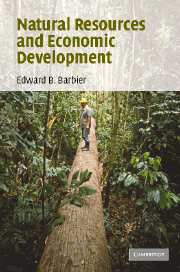Book contents
- Frontmatter
- Contents
- List of figures
- List of tables
- Acknowledgments
- Introduction
- 1 Natural resources and developing countries: an overview
- 2 Natural resource-based economic development in history
- 3 Does natural resource dependence hinder economic development?
- 4 Frontier expansion and economic development
- 5 Explaining land use change in developing countries
- 6 The economics of land conversion
- 7 Does water availability constrain economic development?
- 8 Rural poverty and resource degradation
- 9 Can frontier-based development be successful?
- 10 Policies for sustainable resource-based development in poor economies
- References
- Index
10 - Policies for sustainable resource-based development in poor economies
Published online by Cambridge University Press: 06 July 2010
- Frontmatter
- Contents
- List of figures
- List of tables
- Acknowledgments
- Introduction
- 1 Natural resources and developing countries: an overview
- 2 Natural resource-based economic development in history
- 3 Does natural resource dependence hinder economic development?
- 4 Frontier expansion and economic development
- 5 Explaining land use change in developing countries
- 6 The economics of land conversion
- 7 Does water availability constrain economic development?
- 8 Rural poverty and resource degradation
- 9 Can frontier-based development be successful?
- 10 Policies for sustainable resource-based development in poor economies
- References
- Index
Summary
As discussed in Part One, the very minimum criterion for attaining sustainable development in an economy dependent on exploiting natural resources is that this exploitation satisfies “weak sustainability” conditions. That is, the development path must ensure that, first, natural resources must be managed efficiently so that any rents earned are maximized, and second, the rents resulting from the depletion of natural capital must be invested into other productive assets in the economy.
Historically successful examples of resource-based development have largely adhered to these principles. This includes the past 500 years or so of frontier-based economic development, which is characterized by a pattern of capital investment, technological innovation and social and economic institutions dependent on “opening up” new frontiers of natural resources once existing ones have been “closed” and exhausted. Such development has been mainly successful, particularly during the Golden Age of Resource-Based Development (1870–1913).
However, as maintained throughout this book, frontier-based development in many present-day low and middle-income economies has been much less successful. A key reason is that this development often falls far short of the minimum conditions for attaining sustainable development. What little rents have been generated from this development process have not led to sufficient investments in other productive assets and in more dynamic sectors of the economy. Instead, many poor economies exhibit a “dualism within dualism” economic structure characterized by continuing dependence of the overall economy on mainly primary product exports, a large proportion of the population concentrated on fragile land, and a high degree of rural poverty.
- Type
- Chapter
- Information
- Natural Resources and Economic Development , pp. 344 - 372Publisher: Cambridge University PressPrint publication year: 2005



